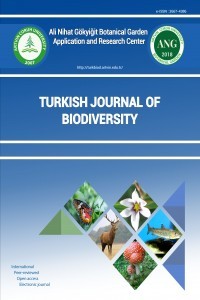Bolkar Dağları (Türkiye) Akreplerine Katkılar
Bolkar Dağları, Akdeniz ve İç Anadolu Bölgeleri arasında ve Niğde, Adana, Karaman, Konya ve Mersin il sınırları içinde yer alan Orta Toroslar’ın oluşturduğu dağ grubudur. 2010 yılı Temmuz-Eylül ayları arasında 31 farklı lokaliteden 151 akrep örneği toplanmıştır. Araziden elde edilen örneklerin değerlendirilmesi sonucu Euscorpiidae’ye ait 18 örneğin Euscorpius koci; Buthidae’den 88’i ergin olmak üzere 113 örneğin Aegaeobuthus gibbosus; Luridae’den 13 örneğin Protoiurus asiaticus ve Scorpionidae’den 7 örneğin Scorpio fuscus olduğu belirlenmiştir. Elde edilen veriler doğrultusunda, Bolkar Dağları’nda dağılım gösteren akrep türlerinin sistematikleri, morfolojik ve morfometrik özellikleri ile her türe ait biyo-ekolojik gözlemler hakkında bilgi verilmesi hedeflenmektedir.
Anahtar Kelimeler:
Scorpiones, , Bolkar dağları, , Escorpiidae, , Luridae, , Scorpionidae, , Buthidae
Contributions to the Scorpions of the Bolkar Mountains (Turkey)
Bolkar Mountains that is mountain group located between Inner Anatolia and Mediterranean region in the city borders of Niğde, Adana, Karaman, Konya and Mersin Provinces. 151 scorpion samples collected from 31 different localities from July to September in 2010. As a result of the evaluation of samples of terrain, 18 Euscorpius koci samples from Euscorpiidae; 113 Aegaeobuthus gibbosus samples from Buthidae (88 adult); 13 Protoiurus asiaticus samples from Luridae and 7 Scorpio fuscus samples from Scorpionidae were determined. Finally, this study gave information about systematics, morphological characteristics and bioecological observation of scorpions distributed in Bolkar Mountains.
Keywords:
Scorpions, Bolkar montain, Escorpiidae, Scorpionidae, Buthidae, Luridae,
___
- Birula A (1898). Ein Beitrag zur Kenntnis der Skorp-ionenfauna Kleinasiens. Horae Societatis Entomologicae Rossicae 33:132–140.
- Birula A (1903). Miscellanea scorpiologica V. Ein Beitrag zur Kenntnis der Scorpionenfauna der Insel Kreta. Annuaire du Musée zoologique de l'Académie impériale des sciences de St.-Péters-bourg 8: 295–299.
- Crucitti P (1999). The scorpions of Anatolia: biogeographical patterns Società Rornana di Scienza. Naturali-Ente di ricerca pura, Via Fratelli Maristi, 43-I-00137 Roma.
- Crucitti P, Vignoli V (2002). Gli scorpioni (Scorpiones) dell’Anatolia sudorientale (Turchia). Bollettino del Museo Regionale di Scienze naturali 19 (2): 433-480.
- Çiplak B (2004). Biogeography of Anatolia: the marker group Orthoptera. Memorie della Societa Entomologica Italiana 82: 357-372.
- Fet V, Braunwalder ME (2000). The Scorpıons (Arachnıda: Scorpıones) of The Aegean Area: Current Problems ın Taxonomy and Bıogeography. Belgian Journal of Zoology 130(1): 15-20.
- Fet V, Graham MR, Blagoev G, Karataş A, Karataş A (2016). DNA barcoding indicates hidden diversity of Euscorpius (Scorpiones: Euscorpiidae) in Turkey. Euscorpius, 216:1-12.
- Francke OF (1981). Taxonomic and zoogeographic observations on Iurus Thorell (Scorpiones, Iuridae). Bulletin of the British Arachnological Society 5: 221-224.
- Froufe E, Sousa P, Alves PC, Harris DJ (2008). Genetic diversity within Scorpio maurus (Scorpiones: Scorpionidae) from Morocco: Preliminary evidence based on CO1 mitochondrial DNA sequences. Biologia 63(6): 1157-1160.
- Karataş A, Çolak M (2005). “Scorpions of Gaziantep Province (Turkey) (Arachnida: Scorpiones). Euscorpius, 30:1-7.
- Karataş A (2007). Mesobuthus nigrocinctus (Ehrenberg, 1828) (Scorpiones: Buthidae) in Turkey: Distribution and morphological variation. Euscorpius Occasional Publications in Scorpiology 56: 1-10.
- Kovařík F, Fet V, Soleglad ME, Yağmur EA (2010). Etudes on iurids, III. Revision of the genus Iurus Thorell, 1876 (Scorpiones: Iuridae), with a description of two new species from Turkey. Euscorpius 95: 1−212.
- Levy G, Amitai P (1980). Scorpiones, In: Fauna Palaestina, Arachnida I. Israel Academy of Sciences and Humanity 130p.
- Mutun S (2010). Intraspecific genetic variation and phylogeography of the oak gallwasp Andricus caputmedusae (Hymenoptera: Cynipidae): effects of the Anatolian Diagonal. Acta Zoologica Academiae Scientiarum Hungaricae, 56(2): 153-172.
- Polis GA (1990). The Biology of Scorpions. Stanford Univercity Press, 587p.
- Sissom WD, Polis GA, Watt DD (1990). Field and laboratory methods. In: The Biology of Scorpions (Ed. G.A. Polis). Stanford University Press, Stanford, pp, 445–461.
- Stahnke HL (1970). Scorpion nomenclature and mensuration. Entomological News 81: 297–316.
- Soleglad ME, Fet V, Kovařík F, Yağmur EA (2012). Etudes on iurids, V. Further revision of Iurus Thorell, 1876 (Scorpiones: Iuridae), with a description of a new genus and two new species. Euscorpius 143: 1-70.
- Talal S, Tesler I, Sivan J, Ben-Shlomo R, Tahir HM, Prendini L, Snir S, Gefen E. (2015). Scorpion speciation in the Holy Land: multilocus phylogeography corroborates diagnostic differences in morphology and burrowing behavior among Scorpio subspecies and justifies recognition as phylogenetic, ecological and biological species. Molecular phylogenetics and evolution, 91: 226-237.
- Tropea G, Yağmur EA (2015). Two new Euscorpius Thorell, 1876 from Turkey (Scorpiones: Euscorpiidae). Arachnida, 6: 13-32.
- Ubısch M (1922). Über eine neue Jurus-Art aus Kleinasien nebst einigen Bemerkungen uber die Funktion der Kamme der Scorpione. Zoologische Jahrbücher, Abtheilung für Systematik 44(6): 503–516 .
- Vachon M (1951). Prof. Kosswig tarafindan Türkiyede toplanan akrepler hakkinda. Á propos de quelques Scorpions de Turquie collectés par M. le Professeur Dr. Curt Kosswig. Revue de la Faculté des Sciences de l´Université d´Istanbul, ser. B 16(4): 341–344.
- Yayın Aralığı: Yılda 2 Sayı
- Başlangıç: 2018
- Yayıncı: Artvin Çoruh Üniversitesi
